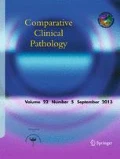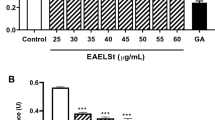Abstract
Mango (Mangifera indica Linn.) has been widely studied as a folk medicines and it has become a common ingredient in cosmeceutical products. However, there was no report on the efficacy of Thai mango leaf extracts against inflammation. Thus, the aim of this study was to ascertain the anti-inflammatory and antioxidant activities of methanol (MeOH) and aqueous (Aq) extracts from the leaves of three mango varieties: Keaw Morakot, Nam Doc Mai, and Mahajanaka. To assay in vitro anti-inflammatory activity, the amount of nitric oxide (NO) released from macrophage cells was indirectly measured. Since free radicals play an important role in the inflammatory process, the antioxidant activity of M. indica leaf extracts was measured by ABTS and DPPH radical scavenging, ascorbic acid, and total phenolic assays. Mangiferin was also analyzed by HPLC. The most effective extract was selected and tested for anti-inflammatory activity in an animal model, an acute ear edema test in albino rats. The MeOH extract of Mahajanaka (M-MeOH) reduced nitric oxide production by LPS-stimulated macrophage cell lines RAW 264.7. M-MeOH showed the strongest antioxidant activity and it was, therefore, selected for an in vivo anti-inflammatory assay. An acute ear edema test in albino rats showed that M-MeOH exhibited significant anti-inflammatory activity compared to the control; ethyl phenylpropiolate-induced ear edema (P < 0.05). Moreover, mangiferin, a bioactive compound in M. indica leaves was detected in MeOH and Aq extracts. We concluded that the MeOH extract of M. indica leaves exhibits an anti-inflammatory property, both in vitro and in vivo, due to the presence of efficacious antioxidants.




Similar content being viewed by others
References
Anila L, Vijayalakshmi NR (2003) Antioxidant action of flavonoids from Mangifera indica and Emblica officinalis in hypercholesterolemic rats. Food Chem 83:569–574
Benard O, Chi Y (2015) Medicinal properties of mangiferin, structural features, derivative synthesis, pharmacokinetics and biological activities. Mini Rev Med Chem 15(7):582–594
Brand-William W, Bondet V, Berset C (1997) Kinetics and mechanisms of antioxidant activity using the DPPH free radical method. Lebensm-Wiss Technol 30:609–615
Brattsand R, Thalen A, Roempke K, Kallstrom L, Gruvstad E (1982) Influence of 16 alpha, 17 alpha-acetal substitution and steriod nucleus fluorination on the topical to systemic activity ratio of glucocorticoids. J Steroid Biochem 16(6):779–786
Carvalho RR, Pellizzon CH, Justulin LJ, Felisbino SL, Vilegas W, Bruni F, Lopes-Ferreira M, Hiruma-Lima CA (2009) Effect of mangiferin on the development of periodontal disease: involvement of lipoxin A4, anti-chemotaxic action in leukocyte rolling. Chem Biol Inter 179:344–350
Conforti F, Menichini F (2011) Phenolic compounds from plants as nitric oxide production inhibitors. Curr Med Chem 18:1137–1145
Dray A (1995) Inflammatory mediators of pain. Br J Anaesth 75:125–131
El-Hawary SS, Rabeh MA (2014) Mangifera indica peels: a common waste product with impressive immunostimulant, anticancer and antimicrobial potency. JNSR 4:102–115
Garrido G, González D, Lemus Y, García D, Lodeiro L, Quintero G, Delporte C, Núñez-Sellés AJ, Delgado R (2004b) In vivo and in vitro anti-inflammatory activity of Mangifera indica L. extract (VIMANG). Pharmacol Res 50:143–149
Garrido G, Delgado R, Lemus Y, Rodríguez J, García D, Núñez-Sellés AJ (2004a) Protection against septic shock and suppression of tumor necrosis factor alpha and nitric oxide production on macrophages and microglia by a standard aqueous extract of Mangifera indica L. (VIMANG). Role of mangiferin isolated from the extract. Pharm Res 50:165–172
Gholkar M, Laddha K (2015) Seasonal variation in the content of mangiferin in leaves of Mangifera indica L. Int J Pharm Pharm Sci 7:578–580
Hannan A, Asghar S, Naeem T, Ikram Ullah M, Ahmed I, Aneela S, Hussain S (2013) Antibacterial effect of mango (Mangifera indica Linn.) leaf extract against antibiotic sensitive and multi-drug resistant Salmonella typhi. Pak J Pharm Sci 26:715–719
Joo T, Sowndhararajan K, Hong S, Lee J, Park SY, Kim S, Jhoo JW (2014) Inhibition of nitric oxide production in LPS-stimulated RAW 264.7 cells by stem bark of Ulmus pumila L. Saudi. J Biol Sci 21(5):427–435
Keardrit K, Rujjanawate C, Amornlerdpison D (2010) Analgesic, antipyretic and anti-inflammatory effects of Tacca chantrieri Andre. J Med Plants Res 4:1991–1995
Krinsky NI (1992) Mechanism of action of biological antioxidants. Exp Biol Med 200:248–254
Lee SY, Kim HJ, Han JS (2013) Anti-inflammatory effect of oyster shell extract in LPS-stimulated Raw 264.7 cells. Prev Nutr Food Sci 18(1):23–29
MacMicking J, Xie QW, Nathan C (1997) Nitric oxide and macrophage function. Annu Rev Immunol 15:323–350
Mohan H (2002) Inflammation and healing. In: Textbook of pathology. Jaypee Publication, New Delhi
Mosmann T (1983) Rapid colorimetric assay for cellular growth and survival: application to proliferation and cytotoxicity assays. J Immunol Methods 65:55–63
Nicholas C, Batra S, Vargo MA, Voss OH, Gavrilin MA, Wewers MD, Guttridge DC, Grotewold E, Doseff AI (2007) Apigenin blocks lipopolysaccharide-induced lethality in vivo and proinflammatory cytokines expression by inactivating NF-kappaB through the suppression of p65 phosphorylation. J Immunol 179:7121–7127
Re R, Pellegrini N, Proteggente A, Pannala A, Yang M, Rice-Evans CA (1999) Antioxidant activity applying an improved ABTS radical cation decolorization assay. Free Radic Biol Med 26:1231–1237
Rice-Evans C, Diplock AT (1993) Current status of antioxidant therapy. Free Radic Biol Med 15:77–96
Sánchez GM, Re L, Giuliani A, Núñez-Sellésd AJ, Davisona GP, León-Fernández OS (2000) Protective effects of Mangifera indica L. extract mangiferin and selected anti-oxidants against TPA induced biomolecules oxidation and peritoneal macrophage activation in mice. Pharm Res 42:565–573
Schlessier K, Harwat M, Bohm V, Bitsch R (2002) Assessment of antioxidant activity by using different in vitro test methods. Free Radic Res 36:177–187
Singleton VL, Rossi JJA (1965) Colorimetry of total phenolics with phosphomolybdic-phosphotungstic acid reagents. Am J Enol Vitic 16:144–158
Sireeratawong S, Itharat A, Lerdvuthisopon N, Piyabhan P, Khonsung P, Boonraeng S, Jaijoy K (2012) Anti-inflammatory, analgesic and antipyretic activities of the ethanol extract of Piper interruptum Opiz. and Piper chaba Linn. ISRN Pharmacol 2012:480265
Yoon SB, Lee YJ, Park SK, Kim HC, Bae H, Kim HM, Ko SG, Choi HY, Oh MS, Park W (2009) Anti-inflammatory effects of Scutellaria baicalensis water extract on LPS-activated RAW 264.7 macrophages. J Ethnopharmacol 125:286–290
Acknowledgements
We would like to thank the Science Achievement Scholarship of Thailand, the Department of Biology in the Faculty of Science at Chiang Mai University and the graduate school, Chiang Mai University and Center of Excellence in Bioresources for Agriculture, Industry and Medicine, Faculty of Science, Chiang Mai University.
Funding
This study was funded by the Science Achievement Scholarship of Thailand, the graduate school, Chiang Mai University.
Author information
Authors and Affiliations
Corresponding author
Ethics declarations
Conflict of interest
The authors declare that they have no conflict of interest.
Ethical approval
All procedures encompassing the animals were conducted with strict adherence to guidelines and procedures reviewed and approved by the Institutional Animal Care and Use Committee of the Biology Department, Faculty of Science, Chiang Mai University, permission number Re. 004/013.
Rights and permissions
About this article
Cite this article
Khumpook, T., Saenphet, S., Tragoolpua, Y. et al. Anti-inflammatory and antioxidant activity of Thai mango (Mangifera indica Linn.) leaf extracts. Comp Clin Pathol 28, 157–164 (2019). https://doi.org/10.1007/s00580-018-2809-z
Received:
Accepted:
Published:
Issue Date:
DOI: https://doi.org/10.1007/s00580-018-2809-z



